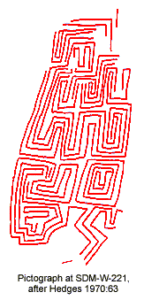Rancho Bernardo Maze Rock Art
A unique rock art style, consisting of frets and maze-like forms, is found along the ethnographically defined boundary between Kumeyaay and Luiseño territories in western San Diego County. Although the majority of the panels occur within Kumeyaay territory, their closest stylistic links appear to be to rock art in the Luiseño area.
Early records of the rock paintings and petroglyphs were made by Garrick Mallery (1893), Julian Steward (1929), H. H. Dunn (1930), and, in unpublished records at the San Diego Museum of Man, by Malcolm J. Rogers. The most intensive study was carried out by Ken Hedges (1970, 1973, 1979, 1985, 1986, 2002; Hedges and Hamann 1987; Kyle 1988). The style has been labelled the Diegueño Rectilinear Abstract Pictograph Style, the Rancho Bernardo Rectilinear Abstract Pictograph Style, the Riverside Maze Petroglyph Style, and the Rancho Bernardo Style.
 The Rancho Bernardo Style is characterized by carefully executed fret elements, generally painted in red but sometimes carved into the rock and occasionally both carved and painted. At their most elaborate, the fret designs resemble labyrinths or mazes, although openings to the outside are not necessarily present. The panels occur most characteristically on exposed eastern faces of large boulders.
The Rancho Bernardo Style is characterized by carefully executed fret elements, generally painted in red but sometimes carved into the rock and occasionally both carved and painted. At their most elaborate, the fret designs resemble labyrinths or mazes, although openings to the outside are not necessarily present. The panels occur most characteristically on exposed eastern faces of large boulders.
Hedges (1987) reported that the Rancho Bernardo Style is represented in at least 38 southern California sites. The largest concentration is in the Rancho Bernardo-Poway area. Farther north, panels are recorded within San Diego County in the Escondido area, Moosa Canyon, Bonsall, Pauma Valley, Warner’s Hot Springs, and Rainbow; in western Riverside County as far north as Moreno; and in Trabuco Canyon in Orange County. In the eastern deserts, the style is represented near Palm Springs, at Travertine Point, and in Blair Valley. To the south of Rancho Bernardo, it is found near Barona, Lakeside, and Dehesa.
Rancho Bernardo has generally been considered to lie within Kumeyaay territory aboriginally, although it is close to Luiseño territory, and some uncertainty exists specifically concerning ethnic boundaries in the Escondido area (cf. Bean 1978; Bean and Shipek 1978; Kroeber 1925; White 1963). Poway, Barona, Lakeside, Dehesa, and Blair Valley were in Kumeyaay territory; Moosa Canyon, Bonsall, Pauma Valley, Rainbow, and Trabuco Canyon were in Luiseño territory; Warner’s Hot Springs was in Cupeño territory; Palm Springs and Travertine Point are in Cahuilla territory; and Moreno may have been in either Luiseño or Cahuilla territory.
Although the greatest florescence of the style is in Rancho Bernardo, Hedges noted that it is not known whether the style originated there and spread outward or was introduced from the north.
Stylistically, the Rancho Bernardo Rectilinear Abstract panels appear to have less in common with the other major Kumeyaay pictograph style, the La Rumorosa Style, which flourished in southeastern San Diego County and northernmost Baja California, than with the San Luis Rey Style found primarily farther north. The geographic range of the San Luis Rey Style overlaps the northern portions of the Rancho Bernardo Style range. The San Luis Rey Style is characterized by repetitive geometrical elements, but is less elaborate and less carefully executed, which has suggested that it may have been produced by puberty-rite initiates. The La Rumorosa Style is notable for curvilinear elements and representations of humans, animals, and other natural objects, although it also contains rectilinear abstract elements such as diamond chains.
There is no direct ethnographic testimony relating to the Rancho Bernardo rock art panels. Their survival on exposed surfaces initially suggested to Hedges that the paintings could not be very old. Later, Hedges and Diane Hamann (1987) argued that the Rancho Bernardo pictographs belonged to the earlier rather than the later portion of the Late Prehistoric period. This conclusion was based on the superposition of San Luis Rey Style pictographs over Rancho Bernardo pictographs, as well as apparent pre-Lake Cahuilla associations of the style at Travertine Point (McCarthy 1981).
The rock art sites are said to occur generally near camp or village sites. Consistent occurrence on east-facing surfaces suggested an association with the ceremonial direction toward which the spirits of the dead were believed to depart, according to Kumeyaay traditions. The complexity and the skillful execution of the paintings suggested that they were produced by shamans rather than by lay participants in some rite. Indeed, the possibility was raised that all of the paintings might have been produced by a single artist (Dunn 1930).
PROSPECTS
Future archaeological investigations may be able to extend or confirm the geographical range of the Rancho Bernardo Style and document the relative frequency of panels within various portions of that range. The chronology, ethnic affiliations, and functions of the style may be clarified by analyzing the orientations of the panels, their accessibility, the skill with which they were executed, and their associations with other rock art styles and other types of archaeological remains. Direct radiocarbon dating of pictographs may be possible.